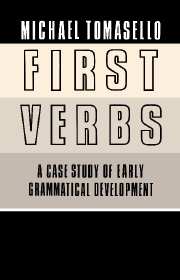Book contents
- Frontmatter
- Contents
- Acknowledgments
- Dedication
- 1 Introduction
- 2 In the beginning was the verb
- 3 Methods and an introduction to T's language
- 4 Change of state verbs and sentences
- 5 Activity verbs and sentences
- 6 Other grammatical structures
- 7 The development of T's verb lexicon
- 8 The development of T's grammar
- 9 Language acquisition as cultural learning
- References
- Appendix
- Index
3 - Methods and an introduction to T's language
Published online by Cambridge University Press: 18 December 2009
- Frontmatter
- Contents
- Acknowledgments
- Dedication
- 1 Introduction
- 2 In the beginning was the verb
- 3 Methods and an introduction to T's language
- 4 Change of state verbs and sentences
- 5 Activity verbs and sentences
- 6 Other grammatical structures
- 7 The development of T's verb lexicon
- 8 The development of T's grammar
- 9 Language acquisition as cultural learning
- References
- Appendix
- Index
Summary
The diary method has a long and venerable history in the study of child language acquisition. From a modern point of view, the problem with the classic diary studies (e.g., Leopold, 1949; Stern & Stern, 1928) is that they attempted to be atheoretical and to describe everything at once. Modern diary studies are more explicit in their theoretical assumptions and tend to focus more narrowly on specific issues of current interest in the field. For example, in studies of their children Dromi (1987) and Mervis (1987) each focused on a specific set of issues in early lexical development, Bowerman (e.g., 1976, 1982) concentrated on her children's “productive errors” of syntax and morphology, and Halliday (1975) cataloged the functional categories into which his child's early language fell. The contributions made by these important studies are proof enough that diary studies have an important role to play, even in the age of video and computer technologies (cf. also Fletcher, 1985). The reason – which is so obvious I will not belabor the point – is that having a relatively complete record for a single child's language allows us to ask important questions that periodic records from a larger population simply do not permit (Mervis, Mervis, Johnson, & Bertrand, in press).
The diary
The subject of the study was my daughter Travis (T). My wife and I kept a diary from T's first stable words at around her first birthday until her second birthday (January 1974 to January 1975).
- Type
- Chapter
- Information
- First VerbsA Case Study of Early Grammatical Development, pp. 30 - 43Publisher: Cambridge University PressPrint publication year: 1992



